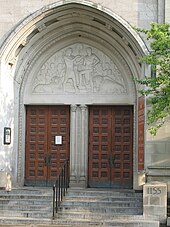University of Chicago Oriental Institute
The Oriental Institute of the University of Chicago ( OI for short ) is one of the leading research centers for Near Eastern antiquity and Egyptology worldwide. Founded in 1919 as an institute of the University of Chicago , it also houses its own archaeological museum and is currently headed by Gil Stein . The Oriental Institute maintains, among other things, one of two professorships for sumerology worldwide, the other professorship is maintained by Heidelberg University .
history
The idea of the Oriental Institute goes back to James Henry Breasted , who also built up the collection of the Haskell Oriental Museum . He proposed to John D. Rockefeller Jr. at the end of the First World War that a research institute should be set up to deal with tracing Western civilization back to its roots in the Ancient Near East . Rockefeller pledged him $ 50,000 for a period of five years. He made the same amount available directly to the University of Chicago for the same purpose. With this money, the Oriental Institute was finally founded in May 1919. It was housed in an Art Deco / Neo-Gothic style building planned by the architects Mayers Murray & Phillip , which was completed in 1930 and inaugurated in 1931.
collection
The museum contains finds from excavations in Egypt , Israel , Syria , Turkey , Iraq and Iran . This also includes Megiddo ivory , a collection of Luristan bronzes , a 40-ton lamassu from Dur Šarrukin and a monumental statue of Pharaoh Tutankhamun . The collection also includes a 500 BC Clay tablet archive dating from the Persian capital Persepolis , since 1973 on loan from the Iranian National Museum and the Iranian Antiquities Organization . The clay tablets, written in an Elamite dialect, provide an insight into everyday life in the Achaemenid Empire , which is otherwise mainly known from the reports of ancient writers such as Herodotus .
Projects
In the 1930s, a series of excavations in the Diyala area of Iraq took place under the direction of Henri Frankfort . This Iraq expedition provided the basis for the internationally accepted chronology of the Early Dynastic Period in Mesopotamia.
In addition to numerous excavations in the Middle East and Egypt, the 23-volume Chicago Assyrian Dictionary was completed by the Oriental Institute . This is a reference work for the Akkadian language that Breasted began in 1921 . In addition, work is currently being carried out in Chicago on a Chicago Hittite Dictionary and a Demotic Dictionary .
Media mention
In 2006, the Oriental Institute became the subject of public controversy when US federal courts decided to confiscate and auction its collection of ancient Persian artifacts. The proceeds from this were to be used to compensate victims of a 1997 bombing in Jerusalem , which the United States claimed was funded by Iran. After this judgment, the collection of Persian clay tablets was also considered to be endangered and the institute began to return the tablets to Iran.
In Raiders of the Lost Ark , Indiana Jones claims to have studied at the Oriental Institute. Allegedly he was modeled after Breasted. Other Indiana Jones role models from Chicago are Edward Chiera (1885–1933) and Robert Braidwood .
literature
- Jeffrey Abt: American Egyptologist. The Life of James Henry Breasted and the Creation of His Oriental Institute. University of Chicago Press, Chicago; London 2011, ISBN 978-0-226-00110-4 .
Web links
- Homepage of the Oriental Institute
- List of previous directors of the Oriental Institute
- Abzu - Guide to open access material on the Ancient Orient
- Database on the Oriental Institute website to document the theft of artifacts from the Iraqi National Museum in April 2003
- Persepolis Fortification Archive Project
- The Oriental Institute: Fragments for a History of an Institution. A collaborative project intended to focus ideas and thoughts on the history of the Oriental Institute of The University of Chicago
Individual evidence
- ^ Peter Slevin: Iran, US Allied in Protecting Artifacts , Washington Post . July 18, 2006, p. A03. Retrieved August 29, 2006.
- ^ Andrew Herrmann: Victims claim win in fight for U. of C. tablets , Chicago Sun-Times . June 27, 2006. Retrieved July 27, 2006.
- ↑ Iranian Antiquities May Be Seized in Suit . June 28, 2006. Archived from the original on September 29, 2007. Retrieved July 27, 2006.
Coordinates: 41 ° 47 ′ 21.5 " N , 87 ° 35 ′ 50.9" W.


